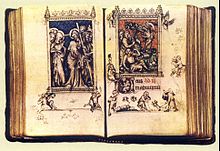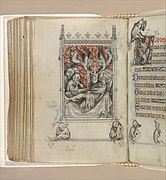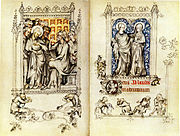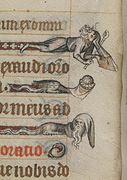Book of hours of Jeanne d'Evreux
The Book of Hours of Jeanne d'Evreux is a book of hours that was created around 1325 to 1328 in Paris and was illuminated by the court painter Jean Pucelle with 24 full-page miniatures and around 700 figures on the side . The small-format book of hours with a format of 9.4 by 6.4 cm follows the Dominican liturgy and is considered an outstanding work of Gothic book illumination . It is of particular art-historical importance, among other things, because with this work Pucelle introduced the grisaille technique into book illumination, which was to remain very popular throughout the 14th century, and because it is the first truly three-dimensional interior representation north of the Alps.

The book of hours was named after Jeanne d'Evreux , the wife of the French King Charles the Fair , for whom the latter had the book made as a gift. It is now kept in New York's Metropolitan Museum of Art .
Miniatures
The Annunciation can be seen on the right of the first double page shown here. The Archangels Gabriel and Mary are inside a Gothic hall, the front of which was opened like a door by a crouching angel. In the open arcade under the roof there are praying angels with two music-making angels. In Domine's figurative Iniatiale D , labia mea aperies (“Lord, open my lips”), Jeanne d'Evreux herself appears as a tiny, crowned figure, kneeling in front of a prayer book. In the border below the two lines of text, some women are playing a board game . The scene on the left depicts the betrayal of Judas Iscariot , underneath a text written in red with the announcement of the Office of Mary and at the foot of the page another incoherent depiction of two men on a goat and a ram who stumble upon a barrel.
The second introductory page shows Christ with the cross and opposite the Annunciation to the shepherds by the angel. The lively angels and other marginal figures complete the scene. The initial below the scene is filled by a bagpipe- playing musician and at the lower left of the picture a shepherd is blowing a shawm . The Gothic decorations on the upper edge of both miniatures give the double page a certain balance, almost symmetry . The two crouching caryatids that support the frame of the miniature can be compared to the angel on the previous page holding the image of the Annunciation.
Queen Jeanne's will
It is historically significant that Queen Jeanne bequeathed her book of hours to the ruling Valois King Charles V (France) . "... first of all for the King, our Lord, a little prayer book that King Charles, God be merciful to his soul, had made for Madame, which Pucelle illuminated" . The mention of the stage name suggests that Pucelle was remembered by the royal family long after his death.
Details
literature
- The Book of Hours by Jeanne d'Evreux. In: John Harthan: Books of hours and their owners. German translation by Regine Klett. Herder, Freiburg (Breisgau) et al. 1977, ISBN 3-451-17907-5 , pp. 40-44.
- Ingo F. Walther, Norbert Wolf: Codices illustres. The most beautiful illuminated manuscripts in the world. 400 to 1600. = masterpieces of illumination. Taschen, Cologne et al. 2005, ISBN 3-8228-4747-X , pp. 208-211.
Web links
- The Book of Hours by Jeanne d'Evreux. inmediaONE GmbH. ( Memento from April 15, 2014 in the Internet Archive )
Individual evidence
- ↑ Emanuel Winternitz: Bagpipes for the Lord. In: The Metropolitan Museum of Art Bulletin. New Series, Vol. 16, No. 10, June 1958, pp. 276-286, here p. 279








